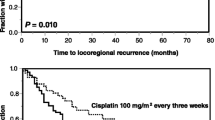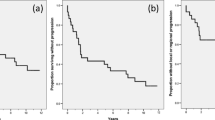Summary
Twenty-two patients are evaluable for response in a Phase II trial of Mitoxantrone for advanced squamous cell carcinoma of the head and neck. One patient had a partial response, one an improvement and twenty had progressive disease. The major toxicities were leukopenia and thrombocytopenia. There was no significant antitumor activity of Mitoxantrone in this group of patients with head and neck cancer, most of whom were previously treated with radiation and chemotherapy.
Similar content being viewed by others
References
Von Hoff DD, Pollard E, Kuhn J, Murray E, Coltman CA Jr: Phase I clinical investigation of 1/4-dihydroxy-5,8-bis {{2-[(2-hydroxyethyl) amino] ethyl} amino}-9,10 anthra cenedione dihydrochloride (NSC 301739), a new anthracene dione. Cancer Res 40:1516–1518, 1980
Schell FC, Yag HY, Glumenshein G, Valdivieso M, Bodey G: Potential cardiotoxicity with mitoxantrone. Cancer Treat Rep 66:1641–1643, 1982
Parker CM: Accuracy of predictions of survival in later stages of cancer Br Med J 2:29–31, 1972
Author information
Authors and Affiliations
Rights and permissions
About this article
Cite this article
Mattox, D.E., Clark, G.M., Balcerzak, S.P. et al. Southwest Oncology Group study of Mitoxantrone for treatment of patients with advanced squamous cell carcinoma of the head and neck. Invest New Drugs 2, 405–407 (1984). https://doi.org/10.1007/BF00171594
Issue Date:
DOI: https://doi.org/10.1007/BF00171594




